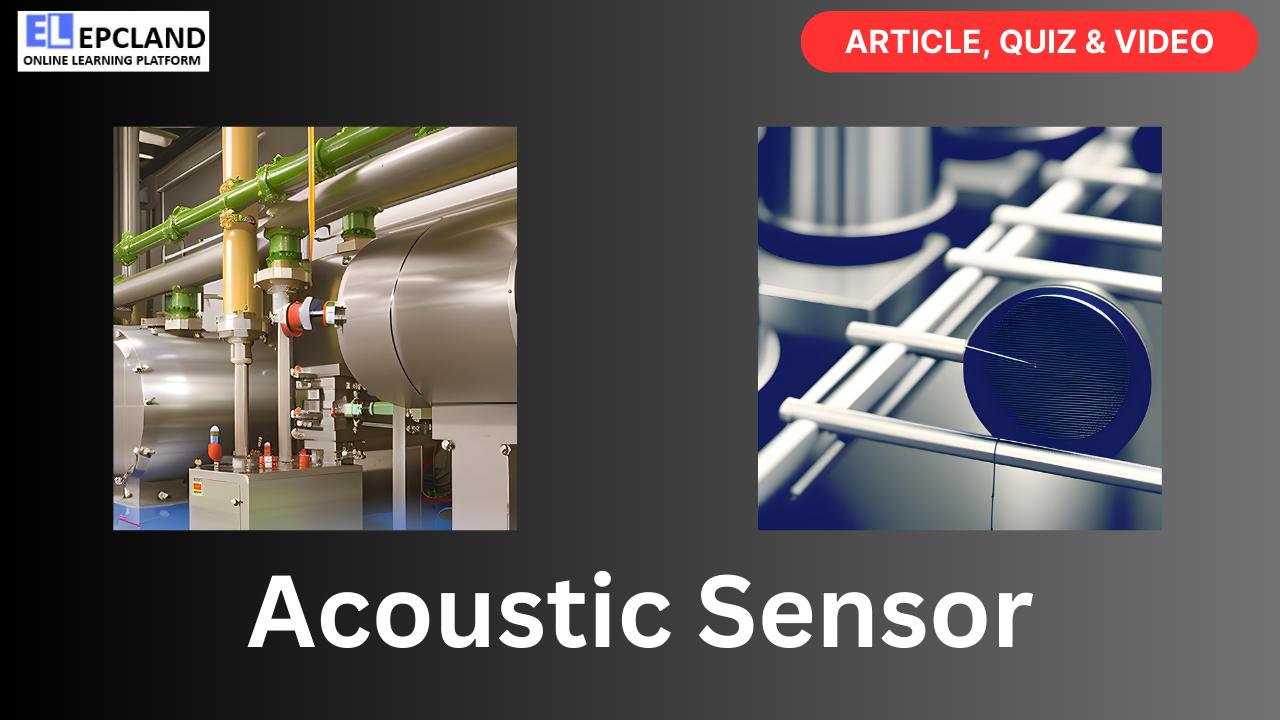Introduction
The Oil & Gas industry has always been at the forefront of technological innovation, seeking new ways to enhance safety, efficiency, and environmental sustainability. One such innovation that has gained prominence in recent years is the use of acoustic sensors. These remarkable devices have proven to be indispensable tools in various facets of the industry, from exploration and drilling to pipeline monitoring and environmental protection. In this article, we will delve into the world of acoustic sensors, exploring how they work, their diverse applications, the advantages they bring to Oil & Gas projects, real-world case studies, and the future trends that hold promise for further advancements.
Table of Contents
Do not miss the Complete Course on Piping Engineering
By EPCLand
Understanding Acoustic Sensors
What Are Acoustic Sensors?
At its core, an acoustic sensor is a specialized device designed to detect and analyze sound waves or vibrations in the environment. In the context of the Oil & Gas industry, these sensors are typically engineered to operate in the challenging and often harsh conditions prevalent in the sector. Acoustic sensors come in various forms, with hydrophones and geophones being two of the most commonly used types.
Hydrophones: These sensors are primarily used for underwater applications, such as subsea exploration and monitoring. They can detect acoustic signals generated by underwater machinery, seismic events, or marine life. Hydrophones are crucial for understanding the acoustic environment in offshore drilling operations.
Geophones: Geophones, on the other hand, are ground-based sensors used for seismic data collection on land. They are essential tools in seismic exploration, helping geologists and engineers understand the subsurface structure and identify potential oil and gas reservoirs.
Working Principle
Acoustic sensors operate on the principle of transduction, which involves converting one form of energy (in this case, acoustic energy) into another form that can be measured and analyzed. The working principle of acoustic sensors can be summarized in the following steps:
- Sound Wave Reception: When an acoustic sensor is exposed to sound waves or vibrations in its vicinity, it vibrates in response to the incoming acoustic energy.
- Transducer Element: Acoustic sensors are equipped with a transducer element, which is typically a piezoelectric material. This material generates electrical signals in response to mechanical vibrations.
- Signal Conversion: As the transducer element vibrates in response to the acoustic energy, it generates an electrical voltage or current proportional to the amplitude and frequency of the incoming sound waves.
- Amplification and Processing: The electrical signal is then amplified and processed by electronic components within the sensor. This processing may include filtering out unwanted noise and interference to enhance the accuracy of the sensor’s measurements.
- Data Output: The processed data is outputted in a format that can be analyzed and interpreted by monitoring systems or operators. This data can include information about the intensity, frequency, and timing of acoustic events.
Applications in Oil & Gas Industry
Acoustic sensors find wide-ranging applications across the Oil & Gas sector, contributing significantly to project success and safety. Let’s explore some of the key areas where these sensors play a pivotal role:
1. Exploration and Seismic Data Collection
One of the fundamental stages in the Oil & Gas industry is the exploration phase. Companies invest substantial resources in identifying potential drilling locations. Acoustic sensors, particularly geophones, are instrumental in this process. They are strategically placed on the ground to record seismic waves generated by controlled explosions or specialized vibrators. By analyzing the data collected, geologists can create detailed subsurface maps, helping pinpoint the presence of hydrocarbon reservoirs.
2. Monitoring of Drilling Operations
Drilling for oil and gas is a complex and costly endeavor, making precision and safety paramount. Acoustic sensors are employed to monitor the drilling process in real-time. They can detect vibrations, pressures, and acoustic anomalies that may indicate drilling complications or equipment malfunctions. This proactive approach allows operators to take immediate corrective actions, reducing the risk of costly accidents or downtime.
3. Pipeline Integrity and Leak Detection
Maintaining the integrity of pipelines is a critical concern for the Oil & Gas industry. Acoustic sensors, specifically hydrophones, are utilized to monitor subsea pipelines for any signs of structural damage or leaks. These sensors can detect acoustic signals generated by escaping gas or liquid, enabling rapid response to mitigate environmental and safety risks. Additionally, geophones are employed along land-based pipelines to detect ground movements that could potentially damage the infrastructure.
4. Environmental Monitoring
The environmental impact of Oil & Gas operations has come under increased scrutiny in recent years. Acoustic sensors are used to monitor noise levels, as excessive underwater noise can harm marine life. By continuously measuring sound levels and implementing mitigation measures, companies can minimize their ecological footprint and adhere to environmental regulations.
Advantages and Disadvantages
Below is a table summarizing the advantages and disadvantages of using acoustic sensors in the Oil & Gas industry:
Do not miss the Complete Course on Piping Engineering
By EPCLand
| Advantages | Disadvantages |
|---|---|
| Increased Safety | Initial Investment Costs |
| Improved Efficiency and Accuracy | Harsh Environmental Conditions |
| Cost-Effectiveness | Data Processing Complexity |
| Environmental Benefits | Interference and Noise |
| Real-Time Monitoring | Calibration and Maintenance Requirements |
| Early Detection of Issues | Limited Detection Range |
| Enhanced Data Analytics | Limited Sensitivity to Certain Frequencies |
Case Studies
To illustrate the practical significance of acoustic sensors in the Oil & Gas industry, let’s examine a few real-world case studies:
Case Study 1: Deepwater Horizon Disaster
The Deepwater Horizon oil spill in 2010 was one of the most catastrophic environmental disasters in history. An explosion on the offshore drilling rig resulted in the release of millions of barrels of oil into the Gulf of Mexico. One of the critical failures in this incident was the inadequate monitoring of pressure and acoustic signals. Had robust acoustic sensors been in place, the signs of trouble could have been detected earlier, potentially preventing the disaster or minimizing its impact.
Case Study 2: Seismic Exploration Success
In contrast to the Deepwater Horizon disaster, successful seismic exploration projects owe a significant portion of their achievements to acoustic sensors. By strategically placing geophones and analyzing the data collected, exploration teams have identified lucrative oil and gas reservoirs, leading to substantial economic gains for their respective companies.
Case Study 3: Pipeline Leak Prevention
A major pipeline operator implemented an acoustic sensor system along its extensive network of pipelines. On multiple occasions, this system detected minute acoustic anomalies that indicated potential leaks. In each case, swift action was taken to inspect and repair the affected sections, preventing significant environmental damage and costly cleanup efforts.
Challenges and Solutions
Despite the undeniable benefits of acoustic sensors, they are not without their challenges when applied in the demanding context of the Oil & Gas industry. Here are some of the primary challenges and the solutions developed to address them:
Harsh Environments
Challenge: Oil and gas operations often take place in extreme environments, including subsea, desert, and Arctic regions, where sensors must endure extreme temperatures, pressures, and corrosive substances.
Solution: Manufacturers have developed ruggedized acoustic sensors designed to withstand these conditions. Specialized materials, coatings, and protective enclosures ensure the longevity and reliability of sensors in harsh environments.
Data Processing and Analysis
Challenge: The volume of data generated by acoustic sensors can be overwhelming. Efficient processing and analysis are essential to extract meaningful insights.
Solution: Advanced data analytics tools, including artificial intelligence and machine learning algorithms, have been integrated with sensor systems. These tools automate data interpretation, enabling real-time decision-making and reducing the burden on human operators.
Interference and Noise
Challenge: In busy industrial environments, acoustic sensors may encounter interference from other equipment or ambient noise.
Solution: Advanced signal processing techniques, such as noise cancellation algorithms, are employed to filter out unwanted noise and enhance the accuracy of sensor readings.
Future Trends
As technology continues to advance, several exciting trends are emerging in the realm of acoustic sensors within the Oil & Gas industry:
1. Internet of Things (IoT) Integration
The integration of acoustic sensors into IoT networks is on the horizon. This will enable seamless data transfer, remote monitoring, and real-time analysis of sensor data, further enhancing operational efficiency and safety.
2. Autonomous Systems
Autonomous drilling rigs and underwater vehicles equipped with acoustic sensors are being developed. These systems can make rapid decisions based on sensor data, improving response times to potential issues.
3. Energy Transition
As the world transitions towards cleaner energy sources, acoustic sensors will play a crucial role in monitoring carbon capture and storage (CCS) projects and offshore wind farms, ensuring the integrity and safety of these installations.
Do not miss the Complete Course on Piping Engineering
By EPCLand
Regulatory and Safety Considerations
In the Oil & Gas industry, adherence to regulatory standards and safety protocols is of paramount importance. When implementing acoustic sensor systems, companies must ensure compliance with industry-specific regulations and guidelines. Additionally, safety protocols should be established for sensor installation, maintenance, and data management to minimize risks and protect personnel and the environment.
Conclusion
Acoustic sensors have undeniably revolutionized the Oil & Gas industry, offering a multitude of benefits that range from increased safety and efficiency to environmental stewardship. Their applications in exploration, drilling, pipeline monitoring, and environmental protection have become indispensable tools for companies operating in this sector. As technology continues to advance and new trends emerge, the role of acoustic sensors is expected to expand, further enhancing the industry’s ability to operate safely, sustainably, and profitably.
In an era where environmental responsibility is a growing concern and operational excellence is non-negotiable, the integration of acoustic sensors is not merely an option but a necessity for the Oil & Gas industry to thrive in the future. By embracing these innovations, companies can navigate the complex challenges of the industry while ensuring a safer and more sustainable energy future for all.
FAQs
- What exactly do acoustic sensors in the Oil & Gas industry detect?Acoustic sensors in the Oil & Gas industry are designed to detect sound waves or vibrations. They can pick up various types of acoustic signals, including those generated by drilling operations, underwater machinery, seismic events, and even pipeline leaks. These sensors play a crucial role in monitoring and providing data related to these acoustic phenomena.
- What are the primary advantages of using acoustic sensors in the Oil & Gas sector?Acoustic sensors offer several key advantages, including increased safety by detecting anomalies and vibrations that could indicate equipment malfunctions or drilling complications. They also contribute to improved operational efficiency, cost-effectiveness, and environmental benefits by helping with early detection of issues such as pipeline leaks and environmental noise pollution.
- What are some real-world examples of how acoustic sensors have made a difference in Oil & Gas projects?Acoustic sensors have been instrumental in various scenarios. For instance, they could have potentially prevented the Deepwater Horizon oil spill disaster in 2010 by detecting pressure and acoustic anomalies early. They’ve also been crucial in successful seismic exploration, identifying valuable oil and gas reservoirs, and in preventing environmental damage by detecting pipeline leaks promptly.
- What are the challenges associated with implementing acoustic sensor technology in the Oil & Gas industry?Some challenges include the initial investment costs, as these sensors can be expensive, and the harsh environmental conditions in which they often operate, such as extreme temperatures and pressures. Data processing complexity can also be a challenge due to the volume of data generated, as well as potential interference and noise from industrial equipment.
- What does the future hold for acoustic sensors in the Oil & Gas industry?The future of acoustic sensors in the industry looks promising. Trends include their integration into the Internet of Things (IoT), enabling real-time data analysis and remote monitoring. Autonomous systems equipped with these sensors are also in development, and acoustic sensors are expected to play a significant role in monitoring carbon capture and storage (CCS) projects and offshore wind farms as the industry transitions to cleaner energy sources.
Recommended courses (Published on EPCLand)
- Basics of Piping Engineering
- Piping Layout Engineering
- Piping Material Engineering
- Piping Stress Analysis
- Complete Course on Piping Engineering
- Material Requisitions
- Piping Material Specifications
- Valve Material Specifications
Don’t miss the published articles on following:
| Article Name with Link | Article Name with Link |
| Future Trends | Basics of Control Valve |
| Principles of Instruments | Control Valves |
| Advanced Control Strategies | HMI Design |
| Automation | PID Controller |
| Calibration | PLC |
| Remote Monitoring and SCADA |
Do not miss the Complete Course on Piping Engineering
By EPCLand
Related Video
Attempt Quiz
Question 1:
What is the primary function of acoustic sensors in oil & gas projects?
Explanation: Acoustic sensors in oil & gas projects are primarily used to detect leaks and anomalies in pipelines and equipment by analyzing sound and vibration data.
Question 2:
Which type of waves do acoustic sensors commonly detect in oil & gas applications?
Explanation: Acoustic sensors commonly detect sound waves in oil & gas applications to monitor equipment and pipeline conditions.
Question 3:
What is the advantage of using acoustic sensors for leak detection in oil & gas projects?
Explanation: One advantage of using acoustic sensors for leak detection in oil & gas projects is that they provide real-time data, allowing for quick response to potential issues.
Question 4:
How do acoustic sensors work in detecting leaks?
Explanation: Acoustic sensors work in detecting leaks by capturing sound and vibration data, allowing for the identification of unusual patterns associated with leaks.
Question 5:
What is the typical placement of acoustic sensors in oil & gas pipelines?
Explanation: Acoustic sensors in oil & gas pipelines are typically placed inside the pipes to monitor for leaks and anomalies directly within the system.



